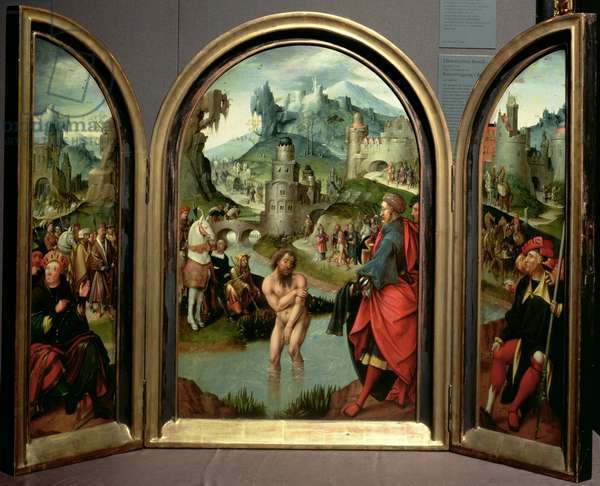What Should We Make of the Story of Elisha and the Bears and What Is the Significance of the Unusual Symbolism in Elisha’s Healings?
by Jeffrey M. Bradshaw
(Originally published August 8, 2018 and August 10, 2018)

Question: One of the most disturbing and incomprehensible accounts in the Old Testament concerns Elisha and the bears who mauled those who jeered at him? What should we make of this strange story?
Summary: The story is one of a sequence of events narrated to emphasize that Elisha was the legitimate successor to his prophetic predecessor, Elijah. Daunted by the prospect of many who would wonder if Elisha could measure up to Elijah’s greatness, Elisha asked for a “double portion” of Elijah’s spirit to rest upon him — figuratively invoking the Deuteronomic law that endows the firstborn and heir of the father with a double portion of his property. As bearer of Elijah’s mantle, Elisha performs similar miracles to Elijah, starting with the parting of the Jordan river, causing those who saw the event to witness, “The spirit of Elijah doth rest on Elisha.” Subsequently, the two brief episodes of the healing of the waters of Jericho and the much misunderstood mauling of the youths who mock the prophet “demonstrate Elisha’s authority and prove that he is the legitimate prophetic heir of Elijah. He has the capacity to bring life and blessing to those who recognize his authority, or death and judgment to those who reject him.” As elsewhere in the books of Kings, the narrator intends to show in no uncertain terms “that contempt toward divinely called prophets is disastrous for God’s people.”
The full article may be found at the Interpreter Foundation website: KnoWhy OTL29A — What Should We Make of the Story of Elisha and the Bears?

Question: Elisha’s request of Naaman to immerse himself seven times in the Jordan River in order to be healed and his “stretching himself” upon a child to raise him from the dead seem highly unusual. Was there any special meaning to Elisha’s actions?
Summary: Like some other Old Testament prophets, Elisha’s invocation of God’s power as he taught and blessed his people was accompanied by actions that symbolized sacred realities. As with modern priesthood ordinances, the physical actions themselves do not bring about the resultant blessings. However, such sacred actions, when required by the Lord, invite participants to reflect about resonances of those actions that extend beyond immediate circumstances and teach eternal principles. Symbolic actions that parallel Elisha’s miracles has at times accompanied healing both anciently and today.
The full article may be found at the Interpreter Foundation website: KnoWhy OTL29B — What Is the Significance of the Unusual Symbolism in Elisha’s Healings?
More Come, Follow Me resources here.
 Jeffrey M. Bradshaw (PhD, Cognitive Science, University of Washington) is a Senior Research Scientist at the Florida Institute for Human and Machine Cognition (IHMC) in Pensacola, Florida (www.ihmc.us/groups/jbradshaw; en.wikipedia.org/wiki/Jeffrey_M._Bradshaw). His professional writings have explored a wide range of topics in human and machine intelligence (www.jeffreymbradshaw.net). Jeff has been the recipient of several awards and patents and has been an adviser for initiatives in science, defense, space, industry, and academia worldwide. Jeff has written detailed commentaries on the Book of Moses and Genesis 1–11 and on temple themes in the scriptures. For Church-related publications, see www.TempleThemes.net. Jeff was a missionary in France and Belgium from 1975–1977, and his family has returned twice to live in France. He and his wife, Kathleen, are the parents of four children and fourteen grandchildren. From July 2016-September 2019, Jeff and Kathleen served missions in the Democratic Republic of Congo Kinshasa Mission office and the DR Congo Kinshasa Temple. They currently live in Nampa, Idaho.
Jeffrey M. Bradshaw (PhD, Cognitive Science, University of Washington) is a Senior Research Scientist at the Florida Institute for Human and Machine Cognition (IHMC) in Pensacola, Florida (www.ihmc.us/groups/jbradshaw; en.wikipedia.org/wiki/Jeffrey_M._Bradshaw). His professional writings have explored a wide range of topics in human and machine intelligence (www.jeffreymbradshaw.net). Jeff has been the recipient of several awards and patents and has been an adviser for initiatives in science, defense, space, industry, and academia worldwide. Jeff has written detailed commentaries on the Book of Moses and Genesis 1–11 and on temple themes in the scriptures. For Church-related publications, see www.TempleThemes.net. Jeff was a missionary in France and Belgium from 1975–1977, and his family has returned twice to live in France. He and his wife, Kathleen, are the parents of four children and fourteen grandchildren. From July 2016-September 2019, Jeff and Kathleen served missions in the Democratic Republic of Congo Kinshasa Mission office and the DR Congo Kinshasa Temple. They currently live in Nampa, Idaho.
The post Come, Follow Me Week 27 – 2 Kings 2–7 appeared first on FAIR.
Continue reading at the original source →



